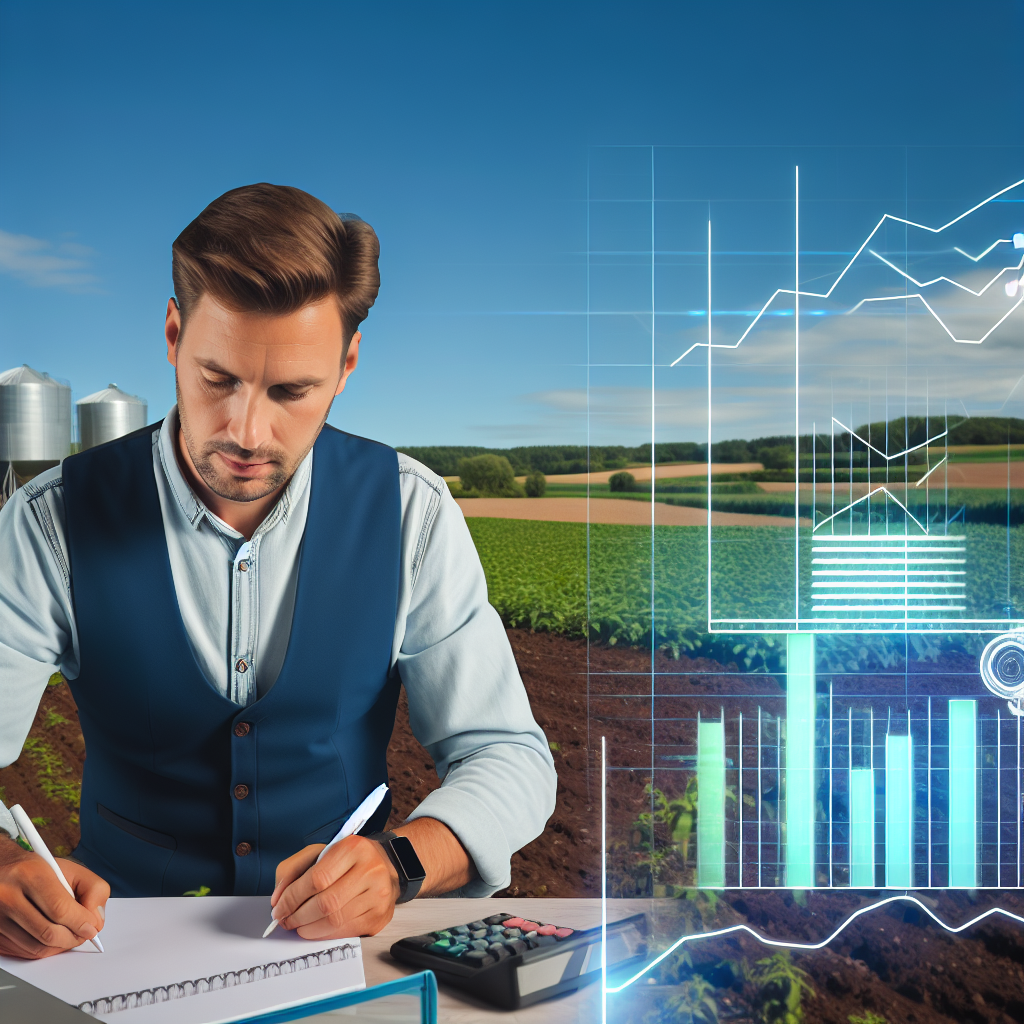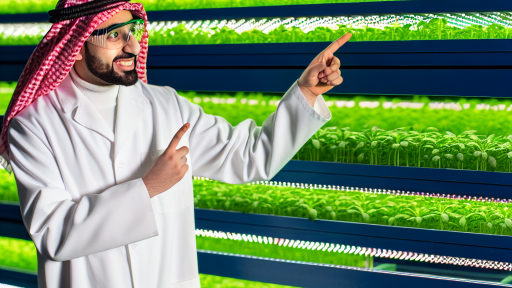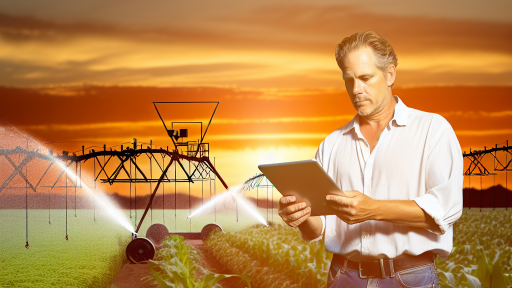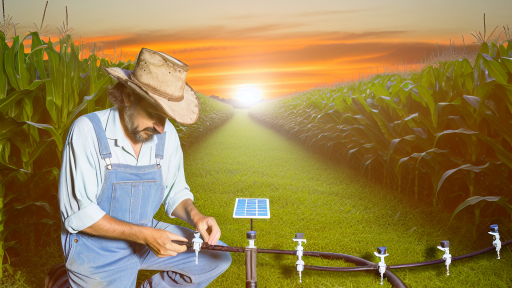Introduction to Data Analytics in Agriculture
Data analytics transforms the agricultural landscape dramatically.
Agricultural professionals increasingly rely on data-driven insights.
This reliance stems from the complex nature of modern farming.
Data analytics helps to optimize planting strategies and resource use.
Moreover, it enhances decision-making processes for farmers.
Understanding Data Analytics
Data analytics refers to the systematic computational analysis of data.
It gathers and examines data sets to derive meaningful conclusions.
In agriculture, this can involve analyzing crop yields and weather patterns.
The process employs various techniques on different types of data.
Consequently, farmers gain insights that can significantly boost profits.
Importance of Data in Farming
Data serves as a cornerstone for modern agricultural practices.
It enables farmers to identify trends and predict outcomes more accurately.
Using data reduces the risks associated with farming decisions.
Additionally, it plays a pivotal role in resource management.
For instance, precision agriculture uses data to optimize inputs efficiently.
Transform Your Agribusiness
Unlock your farm's potential with expert advice tailored to your needs. Get actionable steps that drive real results.
Get StartedTools and Technologies
A variety of tools facilitate data analytics in agriculture.
Farm management software provides farmers with valuable insights instantly.
Moreover, IoT devices collect crucial data from fields automatically.
These technologies allow for real-time monitoring and adjustments.
Furthermore, drones and satellite imagery offer valuable aerial perspectives.
Case Studies of Successful Implementation
Numerous farms have seen significant yield increases through data analytics.
For example, Green Acres Farm adopted a data-driven approach last year.
They utilized soil data and crop performance analytics extensively.
As a result, their overall yield improved by 30% within one season.
This success underscores the potential of integrating analytics into farming.
Understanding the Importance of Farm Yields
Defining Farm Yields
Farm yields refer to the amount of agricultural produce harvested per unit of land.
They serve as a critical measure of farming efficiency and productivity.
Higher yields indicate better resource utilization and crop management.
Economic Significance
Farm yields directly affect a farmer’s income and profitability.
Increased yields can lead to lower production costs per unit.
Additionally, higher yields contribute to food security on a global scale.
Environmental Impact
Maximizing farm yields can lead to more sustainable land use.
Higher efficiency reduces pressure on natural resources.
Moreover, improved yields can decrease the carbon footprint of agriculture.
Technological Advancements
Data analytics plays a significant role in enhancing farm yields.
Technological tools enable farmers to make informed decisions.
This includes precision farming and resource management techniques.
Improving Crop Management
Effective data use helps farmers understand crop needs better.
It enables timely interventions throughout the growing season.
Showcase Your Farming Business
Publish your professional farming services profile on our blog for a one-time fee of $200 and reach a dedicated audience of farmers and agribusiness owners.
Publish Your ProfileThis proactive approach can significantly boost yield outcomes.
Key Data Analytics Tools for Farmers
Geographic Information Systems
Geographic Information Systems (GIS) offer farmers spatial data analysis.
They enable mapping and analyzing agricultural land and resources.
Using GIS, farmers can visualize field variability clearly.
This insight helps in optimizing field management decisions.
Precision Agriculture Tools
Precision agriculture tools enhance farming efficiency significantly.
These tools utilize real-time data collection for informed decisions.
The technology allows farmers to manage their resources effectively.
Additionally, it tailors crop management to specific field conditions.
Crop Management Software
Crop management software streamlines farming operations.
These platforms aid in planning and monitoring crop cycles.
Farmers can track progress and identify potential issues early.
Furthermore, they assist in documenting compliance with regulations.
Weather Forecasting Tools
Weather forecasting tools provide critical information for farmers.
Accurate forecasts help plan planting and harvesting schedules.
They also alert farmers to extreme weather events.
Consequently, this can minimize crop damage and loss.
Data Analytics Platforms
Data analytics platforms aggregate and analyze farm data.
These platforms identify trends and patterns over time.
Farmers can use this information to improve yield predictions.
Ultimately, it enhances overall farm productivity and profitability.
Mobile Applications
Mobile applications offer farmers on-the-go access to data.
These apps support quick decision-making in the field.
They provide updates on weather, soil health, and pest alerts.
Farmers can stay informed and responsive to changing conditions.
See Related Content: Overcoming Challenges In Agricultural Robotics
Collecting and Analyzing Farm Data
Importance of Data Collection
Data collection forms the backbone of modern farming practices.
Farmers can enhance productivity through accurate data.
Moreover, data-driven decisions lead to better resource management.
Collecting data helps identify trends over time.
This information is essential for optimizing crop yields.
Farmers can also pinpoint areas needing improvement.
Types of Data to Collect
Farmers should focus on various data types for comprehensive analysis.
- Soil health metrics, including pH and nutrient levels.
- Weather patterns and climate data for accurate forecasting.
- Crop performance indicators, such as growth rates and yields.
- Pest and disease prevalence monitoring to manage threats.
Additionally, farmers should track operational efficiencies.
These could include equipment performance and labor utilization.
Methods of Data Collection
There are numerous methods for collecting farm data effectively.
Using sensors in fields provides real-time insights.
Drones offer a bird’s-eye view of crops and land conditions.
Farm management software streamlines data entry and analysis.
Regular manual inspections remain essential despite automation.
Showcase Your Farming Business
Publish your professional farming services profile on our blog for a one-time fee of $200 and reach a dedicated audience of farmers and agribusiness owners.
Publish Your ProfileFarmers should combine these methods for optimal results.
Data Analysis Techniques
Analyzing collected data reveals actionable insights.
Farmers can utilize statistical analysis to interpret trends.
Data visualization tools make complex information easier to understand.
Employing machine learning can predict future outcomes.
These techniques help farmers make informed decisions.
Ultimately, effective analysis drives increased farm profitability.
Challenges in Data Collection and Analysis
Farmers face various challenges when collecting and analyzing data.
Data accuracy can be affected by equipment malfunctions.
Furthermore, sorting through vast amounts of data can be overwhelming.
Training and expertise in data analysis are crucial for success.
Overcoming these challenges enhances the benefits of data-driven farming.
Find Out More: Boosting Crop Yields with Remote Sensing Tools
Integrating IoT Devices for Real-time Data Collection
Understanding IoT Technology
IoT devices revolutionize agriculture by enabling real-time data collection.
These devices capture crucial information about crop health and soil conditions.
Farmers can monitor their fields from anywhere using connected technology.
Benefits of Real-time Data
Real-time data allows farmers to make informed decisions quickly.
This immediacy can significantly increase crop yields and resource efficiency.
Additionally, it helps in identifying potential issues before they escalate.
Types of IoT Devices
Various IoT devices enhance data collection on farms.
- Soil moisture sensors track moisture levels in real time.
- Weather stations provide localized climate data for better planning.
- Drones capture aerial imagery for crop assessment.
- Livestock trackers monitor animal health and location.
Data Integration Platforms
Data integration platforms compile information from multiple IoT devices.
These platforms analyze data for actionable insights.
Farmers can access this data through user-friendly dashboards.
Implementing IoT on Farms
Farmers must consider their specific needs before implementing IoT technology.
It is essential to choose the right devices that fit the farming operation.
Many companies offer tailored solutions to meet diverse agricultural demands.
Training staff to utilize these technologies is equally important.
Delve into the Subject: Wireless Sensor Networks for Smart Farming
Utilizing Predictive Analytics for Crop Management
Understanding Predictive Analytics
Predictive analytics involves using historical data to forecast future outcomes.
This method analyzes trends and patterns for informed decision-making.
Farmers can utilize predictive analytics to enhance crop management.
Benefits of Predictive Analytics in Agriculture
Predictive analytics offers numerous advantages for farmers.
- Improves crop yield by optimizing inputs like water and fertilizers.
- Reduces risks associated with weather fluctuations.
- Enhances pest and disease management through timely interventions.
Data Collection and Analysis
Effective predictive analytics starts with robust data collection.
Sensors and IoT devices gather real-time data from fields.
Farmers can monitor soil moisture, temperature, and nutrient levels.
Subsequently, data analysis reveals critical insights for better management.
Implementing Predictive Models
Farmers should adopt advanced predictive modeling techniques.
Machine learning algorithms can identify complex relationships in data.
These models help forecast crop yields based on various factors.
Additionally, they assist in optimizing planting schedules for maximum output.
Showcase Your Farming Business
Publish your professional farming services profile on our blog for a one-time fee of $200 and reach a dedicated audience of farmers and agribusiness owners.
Publish Your ProfileIntegration with Other Technologies
Combining predictive analytics with other technologies enhances benefits.
For instance, drones can provide aerial imagery for in-depth analysis.
Moreover, integrating with Geographic Information Systems (GIS) aids spatial analysis.
Together, these technologies create a comprehensive management strategy.
Real-World Applications
Many successful farms have implemented predictive analytics.
AgriTech Innovations improved yield by 30% through data-driven strategies.
Sunny Acres Farms utilizes predictive analytics for precise irrigation schedules.
Such successes demonstrate the potential of data analytics in agriculture.
You Might Also Like: Automated Machinery for Organic Farming Practices

Case Studies: Successful Adoption of Data Analytics in Farming
Introduction to Data Analytics in Agriculture
Data analytics transforms modern agriculture into a data-driven industry.
Farmers harness data to optimize their operations and enhance productivity.
This process involves the collection, analysis, and application of agricultural data.
The results can be substantial, leading to increased crop yields and better resource management.
Case Study: GreenField Farms
GreenField Farms is a leading example of data analytics in action.
Located in California, this farm integrates various technologies to collect data.
They utilize sensors, drones, and satellite imaging to capture vital agricultural information.
As a result, GreenField can track soil moisture levels and crop health efficiently.
By applying these insights, they adjusted their irrigation practices and saved resources.
Consequently, their overall crop yield increased by 25% in just one growing season.
Case Study: Harvest Innovations
Harvest Innovations represents a successful integration of predictive analytics.
This company specializes in machine learning algorithms to forecast crop performance.
Through historical yield data, they can identify patterns and potential issues.
This information helps farmers plan their planting schedules more effectively.
In one instance, they predicted a pest outbreak, allowing farmers to take preemptive action.
This proactive approach minimized damage and preserved crop health significantly.
Case Study: AgriTech Solutions
AgriTech Solutions provides farmers with comprehensive analytics tools.
Their platform combines various data sources for holistic insights.
Farmers receive recommendations based on real-time data analysis.
This service has enhanced decision-making for numerous farms across the Midwest.
One testimonial noted a 30% reduction in fertilizer costs due to data-driven adjustments.
This approach not only saves money but also promotes sustainable practices.
Challenges and Lessons Learned
Despite the benefits, farmers face challenges in adopting data analytics.
Many lack access to the necessary technology or training.
Additionally, concerns about data privacy and security can hinder adoption.
However, understanding these barriers is essential for overcoming them.
Investing in education and resources can bridge these gaps effectively.
Successful case studies demonstrate that persistence is key to harnessing data analytics.
Challenges and Limitations of Data Analytics in Agriculture
Data Collection Issues
Farmers often face difficulties in collecting accurate data.
This challenge can arise from inconsistent data sources.
Moreover, unreliable sensors may skew results.
Showcase Your Farming Business
Publish your professional farming services profile on our blog for a one-time fee of $200 and reach a dedicated audience of farmers and agribusiness owners.
Publish Your ProfileAdditionally, the high cost of advanced technology can limit access.
Data Interpretation Challenges
Understanding complex data sets requires expertise.
Many farmers lack the necessary training to interpret analytics effectively.
This gap can lead to misinformed decisions about crop management.
Furthermore, data overload can overwhelm users, hindering timely actions.
Integration with Existing Systems
Integrating new data analytics tools with traditional farming methods is challenging.
This process may involve significant adjustments to existing workflows.
Farmers may also face resistance from employees reluctant to adopt new technologies.
Seamless integration remains a key hurdle for many agricultural operations.
Data Privacy and Security Concerns
Farmers worry about the privacy of their harvested data.
Unauthorized access could lead to competitive disadvantages.
Additionally, data breaches can expose sensitive information.
Thus, ensuring robust security measures becomes imperative.
Dependence on External Factors
Data analytics success relies heavily on external data sources.
Weather patterns, for instance, can dramatically affect results.
Inconsistent environmental conditions can lead to unreliable predictions.
Consequently, farmers must remain adaptable to changing circumstances.
The Future of Agriculture: Trends in Data-Driven Farming
Emergence of Data-Driven Technologies
Data-driven technologies are transforming the agricultural landscape.
Farmers now rely on real-time data for decision-making.
Through sensor technologies, they gather crucial information.
Sensors monitor soil moisture, temperature, and crop health.
This data helps optimize crop management practices.
Consequently, yields improve as farmers make informed choices.
Precision Agriculture Techniques
Precision agriculture employs data analytics to enhance efficiency.
It allows farmers to target specific areas needing attention.
This targeted approach minimizes waste and maximizes resources.
Farmers can apply fertilizers and pesticides more effectively.
As a result, they reduce costs and increase profitability.
Integration of Artificial Intelligence
Artificial intelligence plays a vital role in modern farming.
AI algorithms analyze large datasets for actionable insights.
They predict crop performance based on historical data.
This helps farmers plan better and allocate resources wisely.
Moreover, AI enhances pest and disease management strategies.
Farmers can respond swiftly to potential threats.
The Role of Mobile Applications
Mobile applications make data more accessible to farmers.
Farmers can monitor field conditions anytime, anywhere.
These apps provide timely alerts about weather changes.
Additionally, they offer real-time recommendations for farm practices.
Farmers appreciate the convenience and efficiency these tools offer.
Adoption of Drones and Remote Sensing
Drones are revolutionizing data collection in agriculture.
Showcase Your Farming Business
Publish your professional farming services profile on our blog for a one-time fee of $200 and reach a dedicated audience of farmers and agribusiness owners.
Publish Your ProfileThey capture aerial imagery for analysis of crop health.
This technology allows for early detection of issues.
Furthermore, drone data helps optimize irrigation and planting patterns.
Farmers gain valuable insights that promote better decision-making.
Sustainability Through Data Analytics
Data analytics fosters sustainable farming practices.
It enables farmers to use resources efficiently.
This approach minimizes environmental impact significantly.
Farmers can enhance soil health while maintaining productivity.
Ultimately, sustainability ensures long-term viability for agriculture.
Future Trends in Data-Driven Farming
The future of farming lies in continuous innovation.
Emerging technologies will unlock new potentials in agriculture.
As data analytics evolves, farmers will adapt accordingly.
Collaboration among stakeholders will drive advancements further.
Farmers will embrace data as a key ally in their operations.
This shift will pave the way for a more productive and sustainable future.
Additional Resources
CropX Agronomic Farm Management System
Precision Agriculture: Harnessing Technology to Boost Farm Yields …




